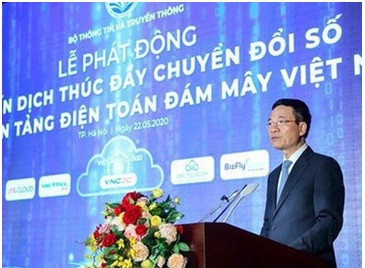Covid-19 - A once in a hundred-year opportunity for digital transformation
Tạp chí online - Ngày đăng : 14:12, 29/12/2020
CHANGE OF USER HABITS

Minister Nguyen Manh Hung shared at the launching ceremony of the campaign to promote digital transformation with Vietnam’s cloud computing technology: “Vietnam must master digital transformation infrastructure and platforms for each industry, and each field”.
Three factors can constitute a barrier to digital transformation, including technology, strategy, and culture. Of which, the biggest barrier when implementing digital transformation, whether in state management agencies, enterprises, or by the citizens, is not the technological factor but the cultural one. Changing habits is the biggest challenge in implementing digital transformation.
Dr. David Bray, CEO of People-Centered Internet (PCI), former CIO of the US Federal Communications Commission, affirmed: "When we talk about technology change, whether it's the Internet of Things, Big data or machine learning, the real problem is still the people. The organizational culture will produce different and better results using these technologies. We need to start focusing on people because any technological change will trigger and require group, organizational and socio-cultural transformation".
Digital transformation is not only a game of technologies, but also the process of changing the creative thinking of leaders and people in businesses and organizations. With digital transformation, every position in a business or organization can be creative. A small improvement can also bring great value. Leaders who have the right perception and come up with a clear digital transformation strategy will succeed. It is not the technology that drives the transformation.
Digital transformation is human transformation. So, it is the most important and decisive factor. The two main human problems in digital transformation are perception and human resources. Leadership perception is of primary importance, to have determination and leadership of your organization to transform digitally, then to awareness of all members of the organization. Human resources involved in training, both training for the elite and the entire force involved in production.

However, changing habits is always difficult for most individuals and organizations. When we are confronted with change, our tendency to react to our habits is the source of resistance to change. Meanwhile, for organizations, especially large-scale organizations, mechanisms have been built to maintain stability. Consequently, formal organizational structure, labor specialization, specific provisions on duties and responsibilities, procedures, regulations, and working methods are all factors hindering the change. Digital transformation requires completely changing the old habits of businesses, organizations, and individuals. Therefore, it encountered many obstacles.
However, the Covid-19 pandemic suddenly appeared, pushing organizations and enterprises into a situation where change is inevitable. Social distancing and lockdown have forced people to adapt with tools for work and distance learning. Never before have people actively searched, learned, and used online tools.
According to the Vietnam Telecommunications Authority (Ministry of Information and Communications), Internet traffic in Vietnam in March 2020 has increased by 90%, due to the need to work from home, especially online teaching, and learning.
Most primary schools, secondary schools, high schools, and even universities also deploy online education for their students. Thereby creating a habit of helping students and parents to use fluently teamworking software such as Microsoft Teams, Zoom, Google Meet, etc. Similarly, in the context of Covid-19, state management agencies, and businesses have to deploy digital applications. From the point of being forced to use, after a while, new habits have been formed, many people have seen more clearly the benefits that digital transformation brings.
ACCELERATION OF THE DIGITAL TRANSFORMATION PROCESS
According to Minister Nguyen Manh Hung, in the past period, we have witnessed a big transformation in the application of technology in the activities of government agencies, especially the healthcare and education sectors. Enterprises under the pressure of the epidemic have proactively applied technology, changing the operation methods and models to adapt and develop.
Facing the impacts of the COVID-19 pandemic on the entire society in the first 6 months of 2020, the Party and State have "turned risks into opportunities", helping Vietnam to make important steps forwards in all fields. Vietnam is one of the few countries that can develop IT applications to prevent, control, and transform life into a new normal state with more than 20 applications serving the Steering Committee, authorities, and people in epidemic prevention and control. This is because Vietnamese businesses have mastered the technologies.
Along with that, Vietnamese businesses have also been very responsive, quick, and proactive in seizing opportunities to build and deploy platforms and solutions to dominate the domestic market. Large technology corporations in Vietnam such as VNPT, Viettel, FPT, etc. have quickly deployed many solutions in many different fields, serving remote working and learning needs, thereby promoting the digital transformation.
According to statistics from VNPT, the online learning service VNPT E-learning also had great growth in the months of COVID-19. Since the beginning of February 2020, more than 11,000 schools have implemented this platform, bringing the total number of participating teachers' accounts to more than 425,000 and more than 5 million students' accounts with nearly 320,000 lectures.
Meanwhile, also in the education field, Viettel has quickly launched a series of solutions to attract users to its learning social network Viettelstudy. Thereby, Viettelstudy had strong growth in the COVID-19 season. Just one month after promoting the attraction of users, this online learning solution has been applied in nearly 26,000 schools across the country with nearly 29,000 newly created lessons and accesses of up to 41 million.
In the healthcare industry, the Covid-19 pandemic rang alarm bells about cross-contamination in the hospital environment. That fact raises the need for solutions for remote medical examination, diagnosis, and treatment. Very quickly, Vietnam deployed this technology when on September 25th, 2020, in Hanoi, the Ministry of Health held the Launching Ceremony of 1,000 Telehealth facilities. This is an important milestone, a great step forward for the healthcare sector in healthcare for the entire population.
ThedrasticdirectionoftheGovernment,thequickandeffectiveparticipationofenterprisesaswellasthechangeinhabitsofmany Vietnamesepeople during theCOVID-19pandemicaresaidtohavehelpedspeedingupthedigitaltransformationprocessinVietnam.
AstheMinisterofInformationandCommunicationsNguyenManhHungshared,besidesthechallenges,theCOVID-19 pandemicalsobringsopportunitiesfor Vietnam.COVID-19isaonceinahundred-yearopportunityfordigitaltransformationandalsoa"hundred-yearpush"todigitallytransform.So,allfieldsoftheinformationandcommunicationindustrymustcreatebreakthroughs,becausethisistheindustrythatleadsthenationaldigitaltransformation agenda.
